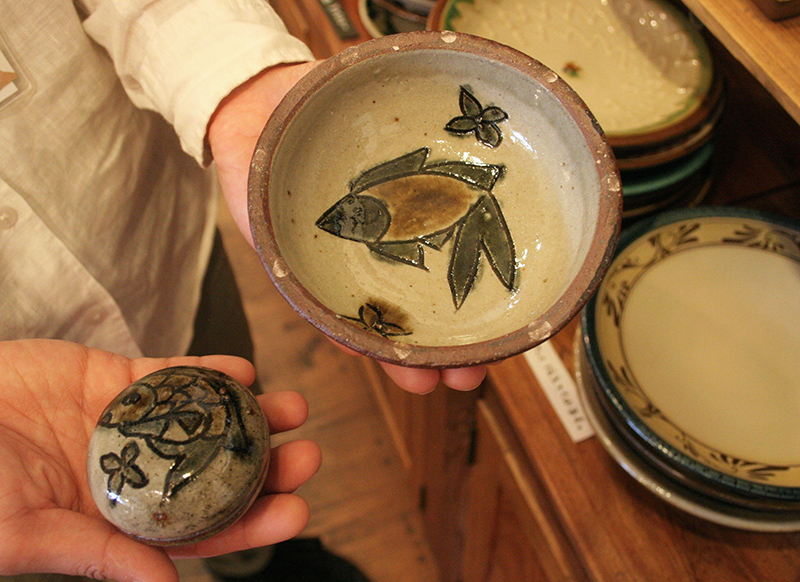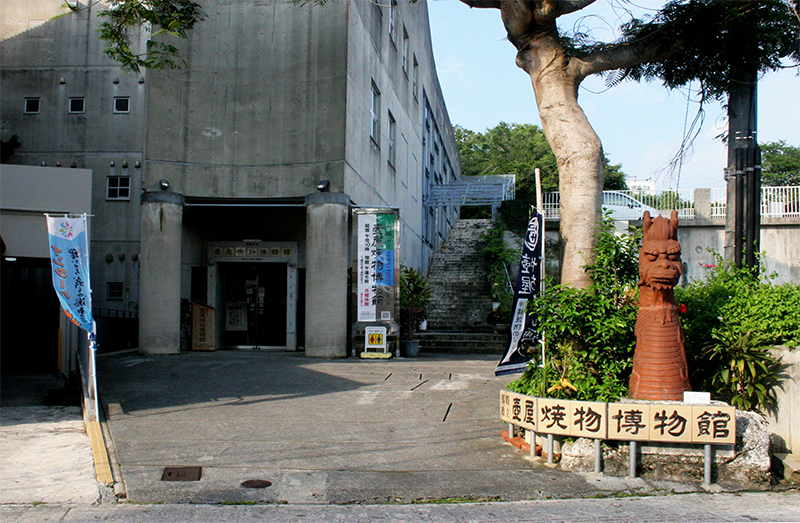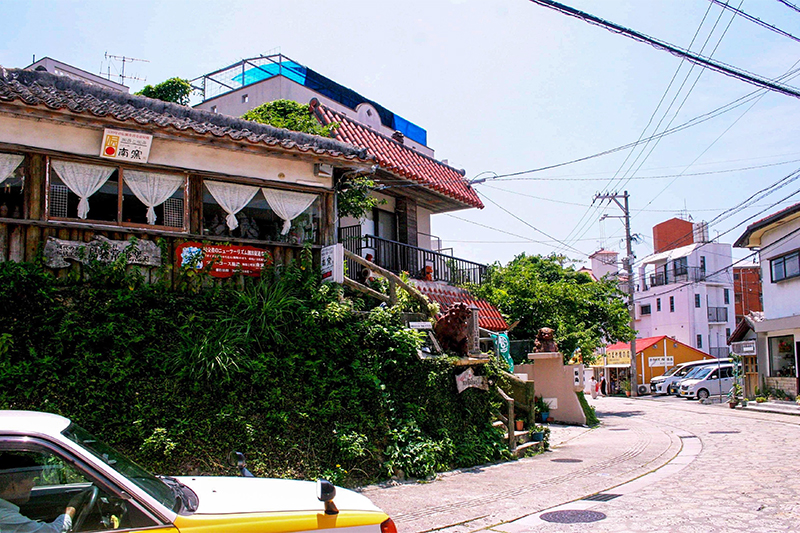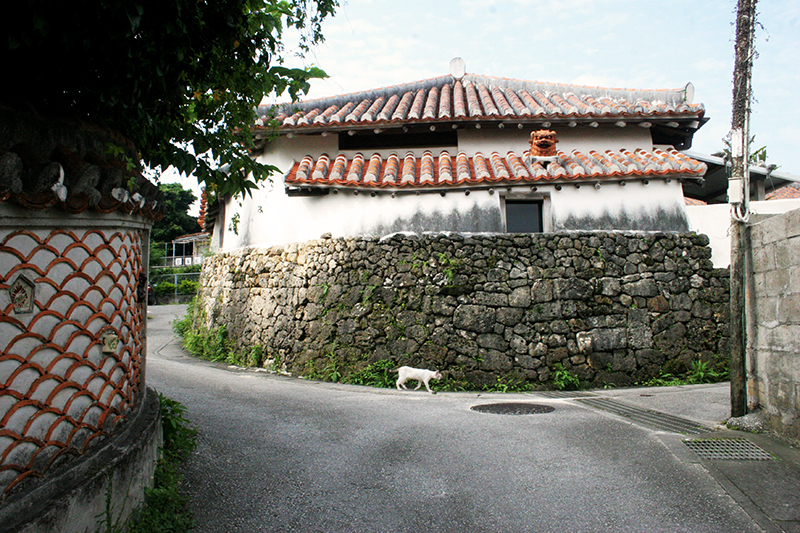Have you heard of Okinawa’s traditional craft called “Yachimun”? Yachimun means pottery in Okinawa dialect. Tsuboya Yachimun Street, located in Naha City, is a place where you can learn about the culture and tradition behind Yachimun. The houses with red-tiled roofs and cobbled streets make the street look very Okinawa-like. Along the street, you can find many stores that sell pottery, and many tourists and local pottery fans visit there.
In this article, we will introduce how to enjoy Tsuboya Yachimun Street and which stores to visit. We will also learn about Yachimun’s history at Naha City Tsuboya Pottery Museum, which is also on the same street.
”Yachimun” - A pottery that expresses the daily life of Okinawa and it’s people

Yachimun has been loved by the people of Okinawa for a long time.(Picture: craft house Sprout)
Pottery often expresses the daily life and culture of people living in the area of its production. Local clay, ceramic glaze, dyes, and other natural materials are used in pottery making. In Japan, there are various kinds of pottery made in different areas, and Okinawa’s Yachimun is one of them. It’s been affected by the culture and history of the tropical island.
Yachimun is known for the thick form and coloring

Yachimun with a fish on it. Yachimuns are usually thick.(Picture: Craft Gift Yacchi to Moon)
There are various types of Yachimun, like Tsuboya pottery made in the Tsuboya area, and pottery made in Yomitanson. In this article, we will introduce the art of Tsuboya pottery, the original form of Yachimun.
It’s known for its thick, simple form and coloring. The colors originate from the colors of Okinawa’s land. Tsuboya pottery can be decorated in many ways, but the most common ones are decorations inspired by Okinawa’s nature, such as fish and chrysanthemums.
Tsuboya pottery is separated into 2 different firing methods: arayachi (荒焼) and joyachi (上焼).
Pottery that doesn’t use ceramic glaze, or uses a ceramic glaze that turns black, is called arayachi. The clays used in arayachi are black and red clay taken from the mid-southern part of Okinawa’s main island.
Joyachi is pottery made with a ceramic glaze. Joyachi is made with red and white clay taken from the mid-northern part of Okinawa’s main island.
Pottery made to store things like water and alcohol are made with arayachi, and many daily objects, like plates, teapots, and bowls, are made with joyachi.

Shisa made with arayachi to show the texture of the local clay (Picture: Yachimunya)
Joyachi pottery has more vibrant colors because it uses ceramic glazing, but arayachi really shows the texture of the local clay. You can enjoy Yachimon by comparing these two styles.
Varieties are endless! Pottery from bowls to urns

An urn made with joyachi (Picture: Urn store Takaesu)
Yachimun isn’t just bowls, bins and ornaments. The Yachimun pottery has many different uses that originate from Okinawa’s culture.
For example, there are many different kinds of cups for Okinawa’s famous sake, ”Awamori”. ”Dachibin” is a pot made for transporting awamori. The side of a dachibin is curved, so it’s easy to hold against the body, and it also has holes for a rope. There’s also ”Karakara”, a sake bottle with a thin spout, ”Yushibin”, a bottle used when giving awamori as a present, and ”Taibin”, an awamori bottle used when worshipping.

Awamori bottle “Karakara”
Among the historical awamori bottles, there are many vibrantly colored items made with joyachi. You can see the strong bond Okinawa’s people have with awamori through Yachimon.

Bone storage on display at Naha City Tsuboya Pottery Museum
This is a Yachimun bone storage “zushigame (厨子甕)”.
This Okinawan tradition for the deceased is to first bury a person, then wash their bones after years have passed. The bones are then stored in a bone storage. Zushigame was used to store the bones, and it was made much way bigger than modern urns.
Zushigame comes in many different varieties. There are vibrant ones made to look like Shuri Castle, and also very simple ones. Cremation is very popular now in Okinawa, so Zushigames are no longer used as often.
Yachimun “Shisa”

Chiburu Shisa at Aragaki house near Tsuboya Yachimun Street.
Another popular symbol of Okinawa is ”Shisa”. You will see Shisa’s in various places when you walk around Okinawa.
The origin of Shisa is said to be an imperial guardian lion that was placed in a village to protect them from fires. The imperial guardian lion protecting the villages was made into pottery and spread as a symbol. Shisa pottery started to appear after the 22nd year of the Meiji era. Arayachi Chiburu Shisa (”chiburu” means head in Okinawa dialect) is said to have been one of the first ones made.
Full-body Shisa started to be made around the Taisho and Showa era. After the war, colorful joyachi Shisa started to be made.

Shisa are usually displayed in pairs, male and female. (Picture: Yachimunya)
Shisa are usually displayed in pairs. A male with an open mouth on the right, and a female with a closed mouth on the left. The male is said to drive away Okinawa’s bad spirits called ”Majimun”, and invite happiness through its open mouth. The female is said to keep the happiness in.
The history of Yachimun, born during Ryukyu Kingdom

Naha City Tsuboya Pottery Museum located on Tsuboya Yachimun Street
Yachimun has changed through times together with the life and traditions of Okinawa.
Next, let’s take a look at the history of Yachimun. We visited the Naha City Tsuboya Pottery Museum located in Tsuboya Yachimun Street.

North Shrine located outside of Naha City Tsuboya Pottery Museum
Tsuboya Pottery Museum is a museum located on the Tsuboya Yachimun Street. They display many historical pottery that show how Yachimun was born and developed at Tsuboya, and how it has changed up until now. They also display pottery work made by famous potters. They also have a shrine dedicated to the local guardian ”Tootiikun”. If you want to learn about the history of Yachimun, you can’t miss this museum.
New pottery techniques from North Korean potters
Let’s take a look at Yachimun’s history

A pot on display at the museum.
The beginning of pottery in Okinawa is said to have started with a pot made 6,600 years ago. During the Sanzan period, when 3 polities, Hokuzan, Chuzan, and Nanzan co-existed in Okinawa, all of the polities built their own trading networks and imported pottery from China, North Korea, Thailand, and Vietnam. The pottery techniques started improving with foreign influence.
In 1429, Shouhashi combined the 3 polities, and Ryukyu Kingdom was born. In 1600, a North Korean potter was invited by the Satsuma clan and taught pottery to local people, and so new pottery techniques were introduced to Okinawa. This is how the basics of Ryukyu Kingdom, Okinawa’s Yachimun were born.
Yachimun pottery workshops gather in Tsuboya

Pottery workshops gathered in Tsuboya
In 1982, Chibana, Takaraguchi, Wakuta, and other pottery all around the Kingdom moved to Tsuboya in Naha City (current Tsuboya Yachimon Street). The needs for tile had increased rapidly, and it’s said that the potteries were gathered in the same place to produce tiles quickly while using clay and firewood efficiently.
This is how Tsuboya Pottery was born.
The Ryukyu Kingdom continued until 1879. Okinawa Prefecture was formed due to the abolition of the han system. The pottery skills kept improving while the kingdom continued trading with China and Japan. Okinawa’s Yachimun developed even more.
Tsuboya was the first place in Naha released from the American army
In 1940, Okinawa prefecture became part of the Pacific War, and there were many battles on the land of Okinawa. Miraculously, Tsuboya area was left undamaged.
Since there were pottery workshops left, the potters told the American army that they could make pottery if they were let back to Tsuboya, and so the potters were set free.
Then, they began to make Yachimun again. It is said that Naha’s recovery after the war started from Tsuboya.
The Itchin chrysanthemum bowl, the first Yachimun made in Tsuboya after the war can be seen at the museum.

Itchin chrysanthemum bowl, the first Yachimun made after the war.
After the potters returned, many people started to gather in Tsuboya. A black market started near Tsuboya. Currently, there is a Makishi Public Market near Tsuboya Yachimun Street, also known as “the kitchen of Okinawa”. This market was started by Naha City to control the illegal black market. It is very popular among both tourists and locals.

”First Makishi Public Market”, which is called the kitchen of Okinawa (Before it was moved in 2019)
Find your favorite Yachimun on Tsuboya Yachimun Street

There are many Tsuboya pottery stores and cafes on Tsuboya Yachimun Street.
Yachimun is a traditional Okinawa handcraft that is currently loved by both locals and tourists. Next, we will introduce the best spots on Tsuboya Yachimun Street, and the shops you must visit.
There are many Yachimun factories and shops on Tsuboya Yachimun Street. After you learn the history of Yachimun, look around the stores to find your favorite one.
The home town of Yachimun, Tsuboya

Feenukama
Feenugama, located on Tsuboya Yachimun Street, is the only arayachi’s “noborigama” left in Tsuboya. “Noborigama” is a pottery oven that extends vertically, and it can fire multiple items at once, taking advantage of the movement of the gas. Feenukama is made on the side of a hill. In 1970, noborigamas became forbidden around Tsuboya due to smoke problems, so it’s not currently in use (You can have a look at it).

Pieces of arayachi pottery around the tree speaks of the Feenukama’s history.
Now in Tsuboya area, gas ovens are used instead of noborigamas. Some potters wanted to keep using noborigamas, and moved to an area where they are allowed. That is how Tsuboya pottery was spread to Okinawa’s different areas.
See Shisa on Tsuboya Yachimun Street

Huge Tsuboya Ufu Shisa is located right next to the entrance.
You will see Shisas at many different parts of Tsuboya, but you can’t miss “Tsuboya Ufu Shisa”. “Ufu” means big in Okinawa dialect. It was made by Tsuboya potters and placed at the entrance of Tsuboya Yachimun Street in 2013. It’s the symbol of the town.
It was made at the same time as Saion Square’s Saion Ufu Shisa, so they are siblings. You can find it on Kokusai Street near Yui Rail Makishi Station.

Big Shisa in front of Tsuboya Pottery Center
It is said that the soul and expression of the potter are passed on to the Shisa. When you see one, pay attention to its expression. There are scary ones, cute smiling ones, unique and funny ones. They are all unique, so try to find your favorite.

Cobbled streets of Tsuboya Yachimun Street
Next, we will introduce places we recommend you to visit when you come to “Tsuboya Yachimun Street”.
“Yachimun House”: the owner’s whole family makes Yachimun

Lovely lion couple
Yachimunya is a store on Tsuboya Yachimun Street. The name of the store means “Yachimun House”, and it was named after the fact that the owner’s whole family makes Yachimun. The pottery oven used by Eitoku Aragaki and Eiichi Aragaki is now passed on to the 3rd generation. Lately, they have been moving over to Yomitanson to use noborigama.

Lion that looks like it’s going to start moving any minute. (Made by Yuto Aragaki)
This is pottery of a lion, made by Eitoku Aragaki’s grandson, Yuto Aragaki. Many different lions and dragons are on display around the store.
They also have many famous pottery works potteries, like such as the lion in front of Tsuboya Pottery Center, and the huge Shisa in Aeon Mall Okinawa Rycom. You can see many lively pottery ornaments in Yachimunya.
Urn Store Takaesu displays mainly urns

Urn Store Takaesu is in front of Feenugama.
Urn Store Takaesu was opened right after the war ended by its 1st generation owner Oto Takaesu. The store started by selling arayachi bone storages but currently has mostly urns on display. After the war, the store was called “kaamimachi” (the town of bone storages). It’s easy to tell that this store used to be a symbol of the Tsuboya area.

The name of the person inside is written on the urn.
The store is currently the only Tsuboya pottery urn store. The urns displayed come in many different colors, like navy blue, brown and grey. They also come in many different sizes, for both adults and children. Many people from both Okinawa and outside buy the urns.
craft house Sprout is popular among pottery fans

craft house Sprout
craft house Sprout is a pottery specialty shop that sells pottery made by potters who create classical and traditional potteries. The store has both classic vibrantly colored and decorated Tsuboya pottery, and traditional Okinawa pottery that is thick and tasteful. This store is popular among pottery fans.

Yachimun plate that portrays the beauty of Okinawa.
We found a plate that shows the texture of Okinawa clay well. The dye used is cobalt, a dye used in joyachi, which became widely known after the abolition of the han system. It portrays the blue oceans of Okinawa.

Cutely shaped single flower vase.
This single flower vase is made by a potter who polished his skills at Yomitanson. The potter got into pottery after seeing pottery work even older than Tsuboyas. You can see his influence in the classic tones and overall design.
In this store, you can find many pottery that add something new to the designs, but still, respect Yachimun’s traditional roots. They also sell pottery by potters whose work is hard to get your hands on. The store has both Okinawan potters’ work and works by potters outside of Okinawa.
Craft Gift Yacchi and Moon sell items that women love

Craft Gift Yacchi and Moon
Craft Gift Yacchi and Moon is a Yachimun specialty shop. The store is in a 50-year-old Okinawa house. As soon as you step in, you are greeted by various Yachimun, both traditional and cute.

Makai (Size 5) has a unique big design on it.
This is a “makai” (Okinawan word for a bowl) made in Okinawa’s biggest noborigama using the traditional method. The design is very Tsuboya pottery-like and will brighten up your dining table.

Small plates with various original designs.
If you want to easily incorporate Yachimun into your dining table, we recommend buying small plates. These small plates with a cute sumo wrestler are all made at the store’s factory, and are great as souvenirs. The plate on the left side of the picture is a size 6 from the wave series (there are also sizes 5 and 7, and also other colors). The color tones unique to Yachimun give the plate a modern vibe.

Inside Gift Craft Yacchi and Moon
Take a walk around and see if you can find Yachimun that will add color to your everyday life.
Nostalgic sceneries are also charming

A traditional Tsuboya pottery house “Aragaki House
Tsuboya Yachimun Street’s other interesting features are the old Okinawa houses left untouched. Even though it’s close to Shuri Castle, Tsuboya was miraculously saved from the fires of the war. You can see old cobbled streets and houses with red-tiled roofs around the area.
A traditional Tsuboya pottery house “Aragaki House” is also one of them. It has been designated as an important cultural property by Japan. You can see a Shisa on top of the house making sure that nothing bad comes close to the house.

Shisa and ishigantou on the wall.
Walk through Tsuboya Yachimun Street to learn about the history and life in Okinawa
Tsuboya Yachimun Street is only 400 meters long, but it’s full of Okinawa. You can learn a lot about Okinawa’s history through Yachimun and Tsuboya pottery. Why don’t you make a trip to Tsuboya and find your own Yachimun?
















_600x400.jpg)















_600x400.jpg)


